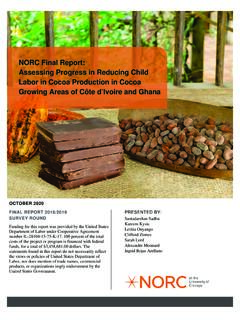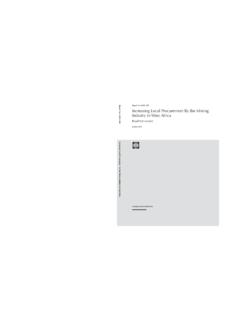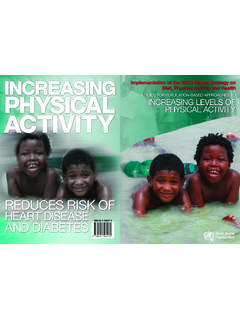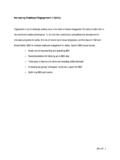Transcription of Rural Evaluation BriefRural Evaluation Brief - norc.org
1 1 Access to safe, reliable, affordable, and convenient transportation improves the livability of Rural communities and quality of life for Rural Transportation connects residents of Rural communities to employment, education, health care, child care, recreation, and other activities of daily life. Transportation also supports Rural economic growth in agriculture, tourism, and service The personal vehicle is central to the transportation landscape in Rural communities. Over 90% of passenger trips in Rural areas occur in automobiles, compared to 84% of trips in urban areas. Public transit is limited in Rural communities: 4% of Rural households use public transit compared to 31% of urban Public transit includes fixed-route services, such as buses, which operate on a predetermined route and schedule; demand-response services, also known as dial-a-ride, which use automobiles, buses, and vans that are dispatched on demand as well as paratransit for people who cannot use fixed-route services ( , people with disabilities); and flex-route services, where drivers deviate from a fixed route upon Transportation safety is also an issue in Rural communities due to limited investments in infrastructure and the increasing use of Rural roads over time.
2 An estimated 40% of roads in Rural areas are currently inadequate for travel, while nearly 50% of bridges over 20 feet long are currently considered structurally The lower population density in Rural communities further contributes to challenges constructing and maintaining transportation systems due to a lack of funding for Rural transit is a significant challenge for many Rural residents who cannot or do not wish to drive, or do not have access to public transit or other transportation modes that meets their needs. The Health Resources and Services Administration s (HRSA) Federal Office of Rural Health Policy (FORHP) funds Rural communities as part of the Section 330A Outreach Authority grant program to address unique health care challenges and increase access to health care services.
3 The Section 330A grant programs are focused on outreach and service delivery; network planning and development; clinical training, recruitment, and retention; emergency services; community and health care services outreach; and benefits counseling, among other services. Many grantees also address social determinants of health, including access to transportation, as a secondary focus area of their projects. One of the lessons learned from the experiences of the Section 330A program is that there is a need to identify and compile promising practices and resources for Rural communities to address community-specific challenges and concerns. The experiences of Section 330A grantees suggest promising strategies that can be adapted and applied in other Rural communities. Grantees have successfully implemented a Key Findings Transportation is a significant challenge for Rural residents who cannot or do not wish to drive, or who do not have access to public transit or other modes of transportation that meet their needs.
4 Barriers to accessing transportation services in Rural communities include long travel distances, low population density, and safety and infrastructure issues. Rural communities are implementing programs that provide transportation to people on demand, for any reason. Mobility on demand models utilize technologies such as smartphones and mobile apps to increase access to transportation. Rural communities are implementing ride-sharing programs using volunteer drivers. When implementing Rural transportation programs, it is important to collaborate with organizations that are working on transportation issues in the community. Rural transportation programs are exploring options to reduce social isolation for older adults and people with Rural Transportation Toolkit is available at: Practices for Increasing Access to Transportation in Rural CommunitiesRural Evaluation BriefRural Evaluation BriefApril 2018 of transportation program models.
5 Examining and compiling promising practices and resources for Rural transportation programs can help guide program development, implementation, and sustainability. Purpose of the ProjectThe purpose of this issue Brief is to summarize promising Rural transportation program models and share lessons learned from Rural communities. The project focused on conducting a literature review of Rural transportation programs and studying the experiences of Rural transportation programs to identify promising practices, resources, and programs. This project culminated in the Rural Transportation Toolkit, a web-based toolkit of Rural transportation program models and resources. The toolkit is hosted on the Rural Health Information Hub (RHIhub) website, available at: Rural communities that are interested in implementing transportation programs may access the toolkit for information on programs, considerations, and Program Models in Rural CommunitiesThis project identified 15 promising Rural transportation program models.
6 These models are implemented in Rural communities and are designed to (1) increase access to transportation, (2) help populations overcome transportation barriers, and (3) improve transportation safety or infrastructure. Rural communities may implement a program that blends several models, depending on their target population, community needs and characteristics, and resources. Models to Improve Access to TransportationModels to improve the availability of and access to transportation in Rural communities include: public transportation, volunteer models, voucher models, coordinated services models, mobility on demand, ridesharing models, connector services, and mobility management. These models help Rural residents travel to schools, businesses, worksites, child care, houses, recreational sites, and shopping, among other destinations.
7 Public Transportation Model. Public transportation systems provide transit services to the public via bus, rail, or other mode on a regular and continual basis. The most common mode of public transit in the is fixed-route bus systems, which operates on a predetermined route and In Rural communities, 32% of bus services provide fixed route However, fixed-route bus services in Rural communities do not operate 24 hours a day, 7 days a week, and residents who have mobility limitations or who do not live or work near bus stops may be unable to access bus routes. Fixed-route bus systems are often supported by demand-response services the second largest type of transportation in the and the main transit provider in Rural areas and communities with low population de n sit Flex-route transportation systems, also called deviated fixed-route systems, where buses leave their regular routes on request, are provided by 43% of Rural bus Rural communities may lack sufficient resources to expand public transportation.
8 Volunteer Model. Many Rural transportation programs rely on volunteers to serve as Volunteer models provide demand-response transportation, often for older adults or people who have disabilities. Some provide door-to-door assistance to their passengers, which is particularly helpful to older adults and passengers with disabilities. Passengers request a ride from one location to another at a specific time often for medical appointments, shopping, and social or recreational activities. Passengers are usually required to schedule a ride in advance. Volunteers often drive their own vehicles. Rural transportation programs implementing a volunteer model must coordinate driver recruitment, background checks, training, and scheduling. Programs may reimburse drivers for the cost of mileage and gas, or offer a voucher for transportation services.
9 Voucher Model. In the voucher model, eligible riders exchange tickets or coupons for a ride from a participating transportation provider. These programs vary in structure programs may offer free rides or reduced fares; eligibility may be based on age, disability, income, or geographic location; and transportation modes may include public transportation and ridesharing. Voucher programs allow riders to choose transit services that meet their unique needs and preferences. The success of voucher programs is dependent upon the availability of transportation programs in the community and coordination between these organizations. Coordinated Services Model. This model involves coordinating and sharing resources, knowledge, and funding to improve transportation Coordinated services models can fill gaps in transportation services and use limited resources more efficiently.
10 Key partners for coordinated services models include human service agencies, non-profits, worksites, transit providers, and local or regional economic development agencies. Mobility on Demand. This model is designed to improve the integration and connectivity of transportation systems. Mobility on demand utilizes technologies such as smartphones and mobile apps to increase access to transportation options, increase convenience, simplify payments, and lower costs. Mobility on demand models are designed to improve the efficiency and effectiveness of transportation Model. Ridesharing is a type of demand-response transportation model that involves sharing a vehicle between one or more organizations (vehicle sharing), combining passenger trips with a common destination (carpooling and vanpooling), or using technology to arrange shared rides on short notice or en-route (real-time ridesharing).







